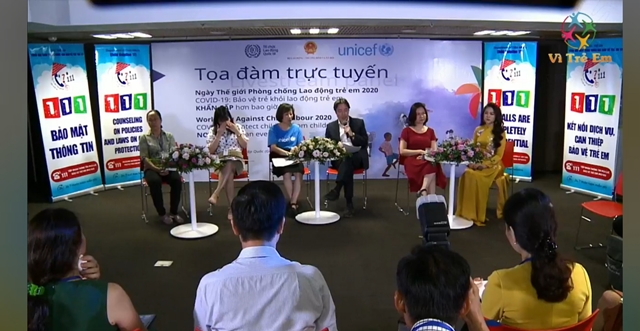Vietnam participates in a global campaign to cope with the rising risk of child labor due to COVID-19
(LDXH) Children need to be protected from child labor more than ever due to the severe effects of the COVID-19 pandemic. That was the message emphasized in the online discussion this morning co-organized by the Ministry of Labor - Invalids and Social Affairs (MOLISA), the International Labor Organization (ILO) and the United Nations Children's Fund (UNICEF) in Hanoi. The event responded to the global call to action on the World Day of Child Labor Prevention.

The event responded to the global call to action on the World Day of Child Labor Prevention
(Source: Television For Children)
A new summary of the ILO and UNICEF has shown that a pandemic could make child labor increase after 20 years in this area. According to the report "COVID-19 and child labor: the period of crisis - the period of action", the number of child labor in the world has decreased to 94 million since 2020, but at this time , that achievement is threatened.
In Vietnam, in April this year - the month of implementing the social distance due to the pandemic, the ILO estimated that between 4.6 and 10.3 million workers could be affected by the pandemic, which would increase the risk of child labor. It was estimated that over one million children aged 5-17 were engaged in child labor in Vietnam, more than half of whom were engaged in hazardous work. When the pandemic affected family income, these children were even at risk of working longer hours or in worse conditions.
“We need to act immediately to protect children from child labor, maintain national efforts to prevent and eliminate child labor”, said Dr. Chang-Hee Lee, Director of ILO Vietnam. He also said that social security played an important role in times of crisis because this system provided support to the most vulnerable groups. The ILO and UNICEF joint report addressed factors that contribute to child labor. Vulnerable populations such as workers in the informal economy and migrant workers will suffer the most from the recession, informalization, rising unemployment, declining living standards, health-related effects and social protection deprivation. COVID-19 can increase poverty, which will lead to rising in child labor because households must use every possible means to survive. Research in some countries shows that when poverty increases by 1 percentage point, child labor increases by at least 0.7 percentage points.
Mrs.Rana Flowers, UNICEF Representative, said: “Children trapped in child labor who are deprived of their childhood, health and education will often suffer from a life of poverty. UNICEF believes that effective action against child labor in the current context requires children to be at the center of the COVID-19 response and recovery plans”. In recent years, the struggle against child labor has made significant progress. However, more and more work is needed to achieve the Sustainable Development Goal (SDG) 8.7 on eliminating child labor by 2025. A quick review of the impact of COVID-19 on child labour is being done nationwide with the support of the ILO. This review will provide information for the development of the National Plan of Action for the Prevention and Reduction of Child Labor for the period 2021-2025.

Speakers participated in the seminar (Source: Television For Children)
Mr. Dang Hoa Nam, Director of the Department of Children (MOLISA) shared: “The effects of COVID-19 on child protection and child labor issue will be addressed by the MOLISA; besides that, concerned ministries and branches will continue to formulate the roadmap of reducing child labor by 2025 and 2030. Let's work hard together, especially in 2021, an international year for child labor prevention and reduction, so that the COVID-19 pandemic will not prevent countries from achieving their sustainable development goals by 2030, especially targets 8.7. ”
Tran Huyen
Translated into English by Minh Ngoc.
-
 Minister Dao Ngoc Dung received the ASEAN’s General Secretary
24-04-2024 10:38 35
Minister Dao Ngoc Dung received the ASEAN’s General Secretary
24-04-2024 10:38 35 -
 Ha Nam province promotes career orientation for students
23-04-2024 14:28 49
Ha Nam province promotes career orientation for students
23-04-2024 14:28 49 -
 Hundreds of job opportunities for people with disabilities in Hanoi
17-04-2024 10:22 29
Hundreds of job opportunities for people with disabilities in Hanoi
17-04-2024 10:22 29
-
 Minister Dao Ngoc Dung received the Chairman of the Korea International Cooperation Agency
21-03-2024 14:14 48
Minister Dao Ngoc Dung received the Chairman of the Korea International Cooperation Agency
21-03-2024 14:14 48 -
 MoLISA proposing Japan to expand occupations to receive Vietnamese workers
18-03-2024 11:12 55
MoLISA proposing Japan to expand occupations to receive Vietnamese workers
18-03-2024 11:12 55 -
 Promote labour relations between Vietnam and Hungary
18-03-2024 09:55 15
Promote labour relations between Vietnam and Hungary
18-03-2024 09:55 15
English Review


Minister Dao Ngoc Dung received the ASEAN’s General Secretary
English Review | 24-04-2024 10:38 35







